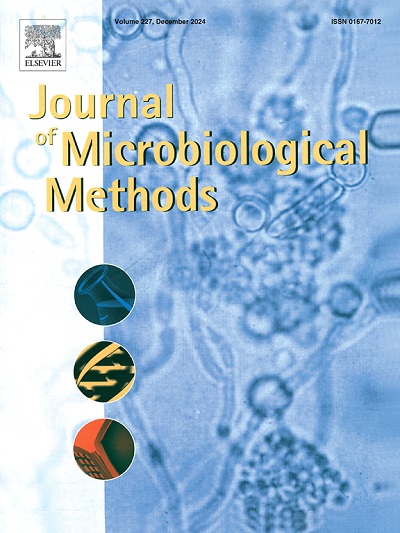肾上腺素对胸膜肺炎放线杆菌分离株生长特性的影响
IF 1.9
4区 生物学
Q4 BIOCHEMICAL RESEARCH METHODS
引用次数: 0
摘要
根据经验观察,猪群中的应激源可能导致定殖猪中胸膜肺炎放线杆菌(App)的爆发。应激激素如儿茶酚胺在体内不仅影响免疫机制,还影响细菌蛋白的表达,因此可以推测它们是疾病发病的关键分子。从载体猪扁桃体组织中分离App进行进一步分型的培养方法大多不成功。本研究测试了培养基中肾上腺素对App生长行为的影响。比较了血清型2、5和12的3株App田间菌株不同龄期(24 h或7 d)在添加不同浓度肾上腺素的培养基中的生长行为。App菌株对肾上腺素的反应因菌株而异。血清5型菌株的CFU/mL和生长曲线特征在不同肾上腺素浓度间差异最大。除1株ST5菌株外,100 μM肾上腺素可延迟24 h起始培养细菌生长曲线的拐点。在所有ST2和ST12菌株以及一个ST5菌株中,100 μM的肾上腺素在7天培养时比24小时培养时具有生长优势。肾上腺素并不能持续促进App的生长,因此不能推荐作为生长培养基的补充,以促进从亚临床感染猪的定植扁桃体中分离。本文章由计算机程序翻译,如有差异,请以英文原文为准。
Effect of epinephrine on growth characteristics of Actinobacillus pleuropneumoniae field isolates
Based on empirical observations, stressors in swine populations may contribute to outbreaks due to Actinobacillus pleuropneumoniae (App) in colonized pigs. Stress hormones as catecholamines were found to impact immune mechanism but also bacterial protein expression in vivo, so it can be hypothesized that they are key molecules in disease pathogenesis. Culturing methods to isolate App from tonsillar tissue of carrier pigs for further typing are mostly not successful. In this study the effect of epinephrine in culturing media on App growth behavior was tested. Starting cultures of different age (24-h-old or 7-day-old cultures) of three App field strains per serotypes 2, 5 and 12 were compared in their growth behavior in medium supplemented with various epinephrine concentrations. The response of App strains to epinephrine varied between strains. Highest differences in CFU/mL and in growth curve characteristics between different epinephrine concentrations were found in serotype 5 strains. Inflection points of bacterial growth curves with 24-h-old starting cultures were delayed with 100 μM epinephrine with exception of one ST5 strain. In all ST2 and ST12 as well as one ST5 strain 100 μM epinephrine led to a growth advantage in 7-day old compared to 24-h-old starting cultures. Epinephrine did not consistently enhance growth of App, so that it cannot be recommended as a supplement for growth media to facilitate isolation from colonized tonsils of subclinically infected pigs.
求助全文
通过发布文献求助,成功后即可免费获取论文全文。
去求助
来源期刊

Journal of microbiological methods
生物-生化研究方法
CiteScore
4.30
自引率
4.50%
发文量
151
审稿时长
29 days
期刊介绍:
The Journal of Microbiological Methods publishes scholarly and original articles, notes and review articles. These articles must include novel and/or state-of-the-art methods, or significant improvements to existing methods. Novel and innovative applications of current methods that are validated and useful will also be published. JMM strives for scholarship, innovation and excellence. This demands scientific rigour, the best available methods and technologies, correctly replicated experiments/tests, the inclusion of proper controls, calibrations, and the correct statistical analysis. The presentation of the data must support the interpretation of the method/approach.
All aspects of microbiology are covered, except virology. These include agricultural microbiology, applied and environmental microbiology, bioassays, bioinformatics, biotechnology, biochemical microbiology, clinical microbiology, diagnostics, food monitoring and quality control microbiology, microbial genetics and genomics, geomicrobiology, microbiome methods regardless of habitat, high through-put sequencing methods and analysis, microbial pathogenesis and host responses, metabolomics, metagenomics, metaproteomics, microbial ecology and diversity, microbial physiology, microbial ultra-structure, microscopic and imaging methods, molecular microbiology, mycology, novel mathematical microbiology and modelling, parasitology, plant-microbe interactions, protein markers/profiles, proteomics, pyrosequencing, public health microbiology, radioisotopes applied to microbiology, robotics applied to microbiological methods,rumen microbiology, microbiological methods for space missions and extreme environments, sampling methods and samplers, soil and sediment microbiology, transcriptomics, veterinary microbiology, sero-diagnostics and typing/identification.
 求助内容:
求助内容: 应助结果提醒方式:
应助结果提醒方式:


